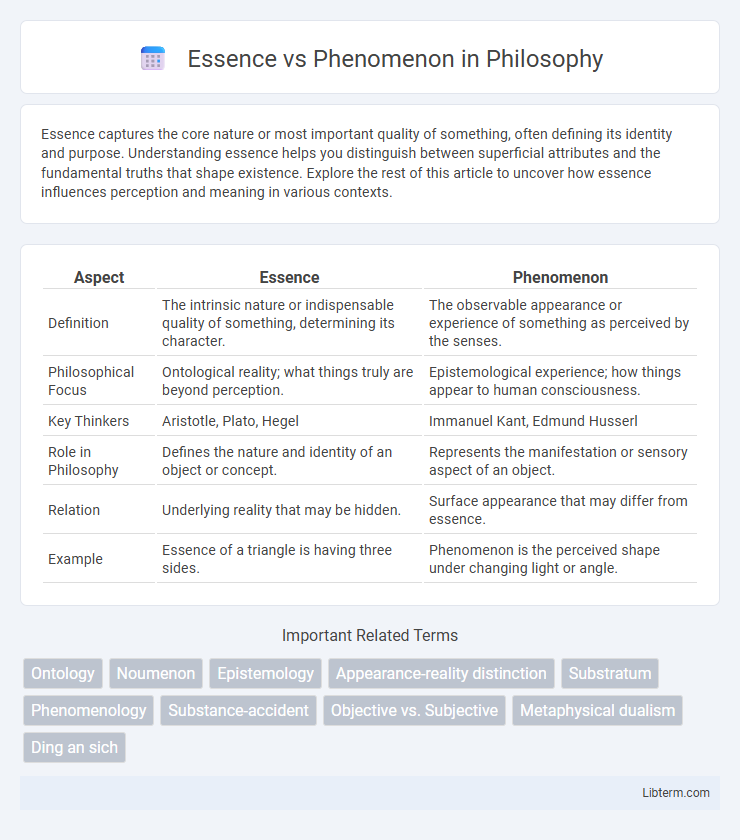Essence captures the core nature or most important quality of something, often defining its identity and purpose. Understanding essence helps you distinguish between superficial attributes and the fundamental truths that shape existence. Explore the rest of this article to uncover how essence influences perception and meaning in various contexts.
Table of Comparison
| Aspect | Essence | Phenomenon |
|---|---|---|
| Definition | The intrinsic nature or indispensable quality of something, determining its character. | The observable appearance or experience of something as perceived by the senses. |
| Philosophical Focus | Ontological reality; what things truly are beyond perception. | Epistemological experience; how things appear to human consciousness. |
| Key Thinkers | Aristotle, Plato, Hegel | Immanuel Kant, Edmund Husserl |
| Role in Philosophy | Defines the nature and identity of an object or concept. | Represents the manifestation or sensory aspect of an object. |
| Relation | Underlying reality that may be hidden. | Surface appearance that may differ from essence. |
| Example | Essence of a triangle is having three sides. | Phenomenon is the perceived shape under changing light or angle. |
Understanding Essence and Phenomenon
Understanding essence involves grasping the fundamental nature or intrinsic quality that defines an entity beyond its observable characteristics. Phenomenon refers to the sensory experience or appearance perceived by observers, which may vary while the essence remains constant. Distinguishing essence from phenomenon enables deeper insight into the core reality underlying superficial experiences.
Defining Essence: Core Meaning
Essence defines the core meaning of an entity by capturing its fundamental qualities that remain constant despite changes in appearance or context. It represents the intrinsic nature that distinguishes an object or concept from all others, serving as the unchanging foundation in philosophical and semantic analysis. Understanding essence allows for clearer differentiation between an entity's true identity and its external manifestations or phenomena.
Phenomenon Explained: Observable Events
Phenomena are observable events or occurrences that can be detected through sensory experience or scientific instrumentation, forming the basis for empirical investigation. Unlike essence, which refers to the inherent nature or fundamental qualities of a thing, phenomena represent the external manifestations that can be measured, recorded, and analyzed. Understanding phenomena allows researchers to gather data and formulate hypotheses about underlying essences or causal mechanisms in various natural and social sciences.
Historical Perspectives on Essence and Phenomenon
Historical perspectives on essence and phenomenon trace back to classical philosophy, where Plato emphasized the existence of unchanging essences behind sensory appearances, contrasting with Aristotle's focus on observable phenomena as the basis of knowledge. Medieval scholastic thinkers, such as Thomas Aquinas, further developed this distinction by integrating Aristotelian ontology with theological principles, prioritizing essence as the foundation of reality while acknowledging phenomena as manifestations of divine order. In modern philosophy, Immanuel Kant redefined the debate by arguing that essence (noumena) remains unknowable beyond human perception, limiting knowledge to phenomena processed through cognitive faculties.
Essence in Philosophy: Metaphysical Roots
Essence in philosophy represents the intrinsic nature or indispensable quality that defines an entity's identity, rooted in metaphysical inquiry. It delves into what makes a thing fundamentally what it is, independent of external appearances or phenomena. This concept traces back to classical metaphysics, notably Aristotle's "ousia," emphasizing substance as the core reality underlying change and existence.
The Role of Phenomenon in Scientific Inquiry
Phenomena serve as observable events or occurrences that provide empirical data essential for developing and testing scientific theories. In scientific inquiry, the phenomenon acts as the tangible basis for hypothesizing, experimentation, and validation, bridging the gap between abstract essence and measurable reality. Understanding phenomena allows researchers to refine concepts, identify causal relationships, and advance knowledge grounded in real-world evidence.
Key Differences Between Essence and Phenomenon
Essence refers to the intrinsic nature or fundamental qualities that define an entity, while phenomenon denotes the observable manifestation or appearance of that entity as perceived by senses. The key difference lies in essence being abstract, unchanging, and underlying reality, whereas phenomenon is empirical, variable, and dependent on perception or experience. Understanding essence requires metaphysical analysis, contrasting with the phenomenological approach that studies phenomena as they present themselves to consciousness.
Interrelationship: How Essence and Phenomenon Interact
Essence and phenomenon interact through a dynamic relationship where essence represents the intrinsic nature or core reality of an entity, while phenomenon manifests as the observable appearance or experience of that essence. The interrelationship highlights that phenomena provide sensory access to essence, enabling perception and understanding, yet phenomena can also obscure or alter the true essence due to subjective interpretation or external conditions. Philosophical frameworks such as Husserl's phenomenology emphasize this interaction by exploring how consciousness reveals essence through the analysis of phenomena, bridging the gap between reality and experience.
Real-World Examples Illustrating Essence vs Phenomenon
Essence refers to the fundamental nature or intrinsic properties of an object, while phenomenon denotes the observable appearance or experience of that object. For example, the essence of water is its molecular composition H2O, whereas the phenomenon includes its states as ice, liquid, or vapor observed under different conditions. In technology, the essence of a smartphone lies in its core functionalities such as computing power and communication capabilities, while the phenomenon involves its user interface, screen responsiveness, and visual display that users interact with.
Implications for Modern Thought and Analysis
Essence, representing the intrinsic nature of a thing, shapes foundational concepts in philosophy and informs analytical frameworks by emphasizing core identities beyond sensory experience. Phenomenon, as the observable manifestation of that essence, drives empirical investigation and experiential understanding in modern thought. The interplay between essence and phenomenon underpins critical methodologies in contemporary epistemology, influencing debates on objectivity, perception, and the limits of knowledge.
Essence Infographic

 libterm.com
libterm.com